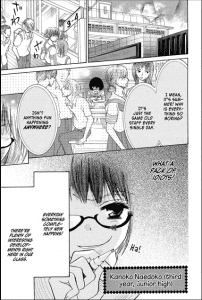 Every story needs an observer, and Kanoko Naedoko is the person for the job in The Secret Notes of Lady Kanoko by Ririko Tsujita. A third-year in junior high school, Kanoko has no friends, but who needs them? They would just get in the way of her 100% objectivity as she observes, records and studies all the juicy information on her classmates. But as Kanoko finds out, just because you don’t want any friends doesn’t mean people won’t still come to you. As she gets close to her classmates will she let the things she sees go by, or will she do something about it?
Every story needs an observer, and Kanoko Naedoko is the person for the job in The Secret Notes of Lady Kanoko by Ririko Tsujita. A third-year in junior high school, Kanoko has no friends, but who needs them? They would just get in the way of her 100% objectivity as she observes, records and studies all the juicy information on her classmates. But as Kanoko finds out, just because you don’t want any friends doesn’t mean people won’t still come to you. As she gets close to her classmates will she let the things she sees go by, or will she do something about it?
The Secret Notes of Lady Kanoko sets up one of the more unique premises I’ve seen in shojo manga. The genre is saturated with stories about girls with love problems and spunky girls with dreams that are too big, but Kanoko is a girl who just likes to watch all those stories unfold. Not bogged down by an unrequited love or devastating drama, Kanoko is able to see how all the threads connect, the only one who really understands what’s going on behind all the love triangles and misunderstandings.
Even though Kanoko likes to paint herself as an observer, it doesn’t mean Tsujita gave her heroine a bland personality. She has a hard edge that, working with her intelligence, makes her more than a match for anyone she goes against, student or teacher. And her blunt delivery of the facts to her clueless subjects shows her secret inability to remain impartial, and is amusing to boot. Even her preference for solitude isn’t a tacked on trait, as some well-placed back-story shows how her experience with unfaithful friends made loneliness so much more appealing.

The only thing that truly irked me in this manga is that Kanoko transfers to another school in each chapter. On the one hand this allows Kanoko to slip back into the role of objective observer even after she’s made connections and – dare I say t? – friends. But unfortunately Tsujita is uncommonly good at getting you to care about a character within pages, and it’s heart-wrenching to see these new friends abruptly left behind.
Thankfully, not everyone is forgotten. Tsubaki, the popular boy from chapter one, reappears in each chapter to help Kanoko with her latest scheme. And all three of Kanoko’s first friends are back in the last chapter when Kanoko visits the cultural festival at her old school. Since Tsujita keeps bringing these old favorites back, it’s possible the manga will settle into an overarching story rather than these episodic chapters. But even if that’s not the case, that’s fine. Lady Kanoko tops out at three volumes, so I feel safe assuming the manga will end before Kanoko’s travels through schools get repetitive.
Character designs are what we’ve come to expect from shojo manga. The girls, aside from Kanoko, are round-eyed and beautiful, and the generically handsome boys are appealing, but a little difficult to tell apart from chapter to chapter. Our bespectacled heroine has a plainer look that would have normally been left to someone meant to fade in the background (something Kanoko would be glad to hear) but Tsujita gives her sharp eyes and a shrewd smile that remind us how smart and conniving she is. As for the backgrounds, Kanoko changes schools each chapter, but it’s impossible to tell the classrooms apart. But even though they don’t give a good sense of place, Tsujita adds enough detail and movement to keep the backgrounds interesting.
Ririko Tsujita’s manga a unique twist on the shojo genre that will likely attract fans finding themselves bored with the usual cookie-cutter heroines. While attachment to characters that are easily left behind can be an issue for some readers, The Secret Notes of Lady Kanoko is a great series to pick up.
ISBN: 978-1-4278-2011-2 • MSRP: $10.99 • Published by Tokyopop • 208 pages


[…] enjoyable that that didn’t matter too much. I’ve also written a review for the manga on Real Otaku Gamer, so check that out to see some more specific opinions on […]
[…] remain worried over what will become of series that remain unfinished in English, like Hetalia and The Secret Notes of Lady Kanoko (recently reviewed on Real Otaku […]